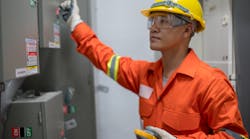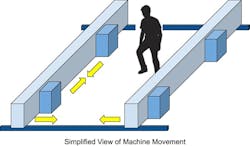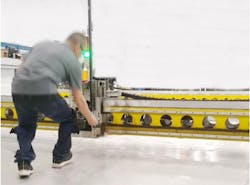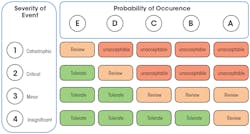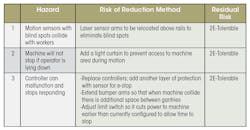With the growth of automation and increase of workers engaging with machines, I felt there would be some benefit to sharing an example of the safety risk assessments that we do in order to reduce or eliminate user hazards in machines.
Risk assessments are commonly used to measure corporate, project, and design risks. The machine risk assessment is specifically for ensuring machine safety. It’s often confused with FMEA (Failure Mode Effect Analysis), which is also used by engineers to improve designs but instead follows a bottom-up assessment method. This requires a different perspective which results in a focus on equipment failure.
The safety risk assessment uses a top-down analysis of risks while creating a systematic and broader approach to mitigate them. Both methods are important, but the top-down view is an essential step—and often more effective for a stakeholder group to engage with.
Case Study: Large Plotting Machine with Walk-in Access
Industrial facilities can be dangerous areas for workers or the public. Identifying, assessing, and removing machine hazards is paramount. One of the tools that’s used to mitigate risk is the Safety Risk Assessment. These are best completed during the design stage before a system is constructed, but if there’s a legacy system that requires a review, a Safety Risk Assessment can be conducted as well. The following example will outline how this process works.
There is a production wire plotting machine with two 20-meter (60 ft) gantries and two moving heads that have four degrees of freedom each. This can present a complicated situation as it was originally designed to have limited user intervention during its operation. After some initial use, the production team found that plotting errors could be reduced if the machine was periodically paused so operators could enter the working zone to make small adjustments on the plotting heads (Fig. 1).
As time went on, the production team started to work around the machine while it was plotting without pausing the operation by simply jumping over the track as it moved. The key safety issue here was collision and crushing.
Simplified view of machine movement
There were existing protection systems in place to prevent user harm and it consisted of photoelectric reflective sensors, extensive operator training, multiple users on the machine at a time, and emergency buttons that were capable of a category 0 stop (immediate removal of energy). Over time, users learned the position of the photoelectric sensor and were able to work around it to avoid stopping the machine (Fig. 2).
Is this machine still safe enough? Is the current safety system enough to provide acceptable protection for the users in all cases? This is where the Safety Risk Assessment is required.
User intervention on part of the moving machine
How to Complete a Safety Risk Assessment
Here’s a five-step process to perform a safety risk assessment. Putting forth the effort in this stage will decrease the likelihood of problems arising in the future.
1. Get your team ready. Create a diverse team of experts and users. Define the scope of work that you are going to perform and spend time to understand the machine through and through. Writing a theory of operation which outlines how the machine works will ensure that everyone is on the same page.
2. Hazard identification. Identify the areas in which human activities occur both inside and around the machine. You’ll need to determine what hazardous events could happen there and how they would be caused. Are they human or machine failure? What hazards will result in harm? What is the severity of the harm that would result from the hazard?
3. Initial risk estimation and evaluation. At this stage, you need to qualitatively evaluate the risk likelihood and severity of each event. Take the time to establish your evaluation process and method. Define what each term means to the team and use a simplified table (Fig. 3).
Severity Probability Table
4. Risk reduction measures. Once the hazards have been identified, the team can choose to completely design them out, develop a process to mitigate them, or install new safeguards. The assessment will determine what areas pose the greatest risk comparatively.
5. Follow-up of estimation and evaluation. Review and assess any residual risk after the proper reduction measures have been implemented. If the residual risk is tolerable, then it can be considered mitigated and the team can include any further risk reduction measures to close it.
Results of the Safety Risk Assessment Steps
This section will take the above process and highlight the findings. It will use a risk assessment matrix to quantitatively measure the level of risk and residual risks after implementing the new safety functions.
1. Get your team ready. The diverse team of experts used to determine the scope consisted of a lead electrical engineer, lead production manager, manufacturing manager, machine operator, and design engineer (original designer). The manufacturing engineer reviews the current function of the machine and how it is currently used.
2. Hazard identification. The team identified a list of hazards that could occur on the machine. Combining their knowledge and expertise to ensure that every possible threat was evaluated.
3. Initial risk estimation and evaluation. The hazards were given a rating to determine their severity before being compiled into a risk assessment matrix. These values can be determined in any way that makes sense to the team. The top four machine hazards that were rated as either “undesirable” or “unacceptable” are listed below (Fig. 4).
Risk Table
4. Risk reduction measures. The unacceptable hazards in this scenario were given top priority to be eliminated. The team identified them and proceeded to make steps towards designing out.
5. Follow-up of estimation and evaluation. Finally, the risk reduction methods were reassessed and the residual risks were determined after the correction measures were put in place (Fig. 5).
Residual Risk Table
In this demonstration, we outlined the steps to perform a safety risk assessment and provided a clear method to understand the quantity and level of risk that could potentially occur using a risk assessment matrix. This top-down approach to eliminating hazard is crucial to the design of any system and the result will be a safer overall environment for the users to operate.
Michael Wrinch is the president of Hedgehog Technologies, an electrical engineering firm specializing in electrical systems, advanced controls, and design for hazardous environments. His personal expertise is with safety critical system designs of control, manufacturing, and automation systems.
